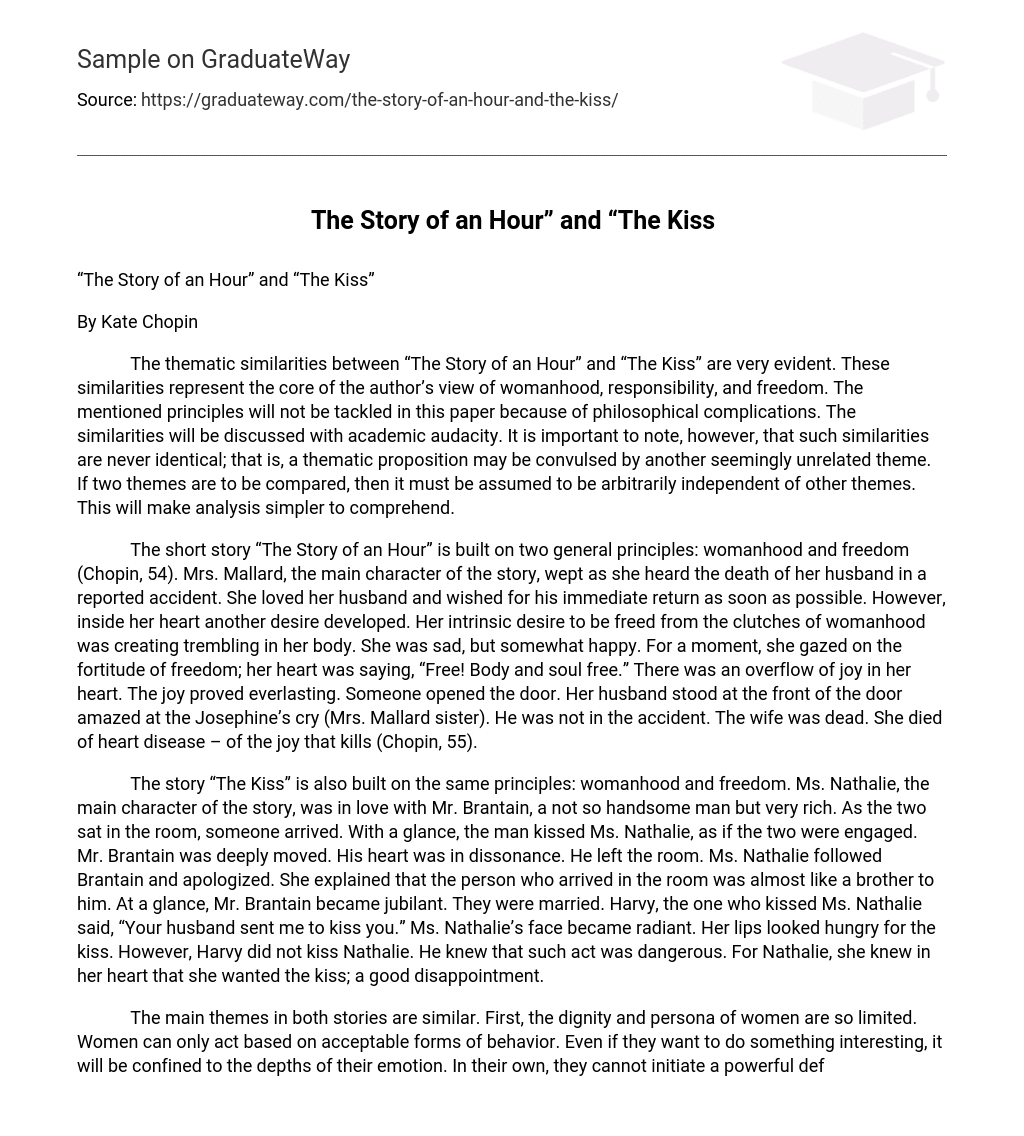The thematic similarities between “The Story of an Hour” and “The Kiss” are very evident. These similarities represent the core of the author’s view of womanhood, responsibility, and freedom. The mentioned principles will not be tackled in this paper because of philosophical complications. The similarities will be discussed with academic audacity. It is important to note, however, that such similarities are never identical; that is, a thematic proposition may be convulsed by another seemingly unrelated theme. If two themes are to be compared, then it must be assumed to be arbitrarily independent of other themes. This will make analysis simpler to comprehend.
The short story “The Story of an Hour” is built on two general principles: womanhood and freedom (Chopin, 54). Mrs. Mallard, the main character of the story, wept as she heard the death of her husband in a reported accident. She loved her husband and wished for his immediate return as soon as possible. However, inside her heart another desire developed. Her intrinsic desire to be freed from the clutches of womanhood was creating trembling in her body. She was sad, but somewhat happy.
For a moment, she gazed on the fortitude of freedom; her heart was saying, “Free! Body and soul free.” There was an overflow of joy in her heart. The joy proved everlasting. Someone opened the door. Her husband stood at the front of the door amazed at the Josephine’s cry (Mrs. Mallard sister). He was not in the accident. The wife was dead. She died of heart disease – of the joy that kills (Chopin, 55).
The story “The Kiss” is also built on the same principles: womanhood and freedom. Ms. Nathalie, the main character of the story, was in love with Mr. Brantain, a not so handsome man but very rich. As the two sat in the room, someone arrived. With a glance, the man kissed Ms. Nathalie, as if the two were engaged. Mr. Brantain was deeply moved. His heart was in dissonance. He left the room. Ms. Nathalie followed Brantain and apologized.
She explained that the person who arrived in the room was almost like a brother to him. At a glance, Mr. Brantain became jubilant. They were married. Harvy, the one who kissed Ms. Nathalie said, “Your husband sent me to kiss you.” Ms. Nathalie’s face became radiant. Her lips looked hungry for the kiss. However, Harvy did not kiss Nathalie. He knew that such act was dangerous. For Nathalie, she knew in her heart that she wanted the kiss; a good disappointment.
The main themes in both stories are similar. First, the dignity and persona of women are so limited. Women can only act based on acceptable forms of behavior. Even if they want to do something interesting, it will be confined to the depths of their emotion. In their own, they cannot initiate a powerful defiant act. And, second, the freedom of women is very restrictive. In the case of Mrs. Mallard, she can only dream of the possibilities (Chopin, 59).
Only a powerful opportunity can alleviate the chains of womanhood. This is not to say that she was unhappy with Brently (her husband). She just want a momentarily relief of the burden she is carrying. The same case can be said about Nathalie (Chopin, 59). She wants the kiss, but by virtue of marriage, such act can be deemed as inappropriate. If not for the hesitation of Harvy, she would have committed a grave “sin” (from the point of view of the society).
In short, when a woman is bound in marriage, her freedom becomes restrictive; her opportunities slackened by such social arrangement. It is by this social arrangement and its associated restrictions on freedom that make a woman thirst for momentary freedom. There are some differences in the way the themes were presented. Note that in “The Story of an Hour”, Mrs. Mallard is already bound in marriage. The story revolves around the confines of marriage.
The restrictions and momentary solitudes of womanhood are generally implied in the fornication of marriage. In short, the starting point of the main themes in the first story is confided in marriage. The pre-marriage arrangement in the second story provides the grounds for the development of the main themes. Only when Nathalie was married were those themes become self-evident. In any case, the themes of the stories are generally similar.
The similarity of the point of view is also self-evident in the two short stories. The author used the third person point of view (with due emphasis on the main characters) to show three important things: the oppressing nature of marriage, the limitations of a woman, and the aspiration to be free.
The first short story is more straightforward than the second one. The reason lies in the progression of the story. The main themes of the first story are already established at the first paragraphs of the story. The main themes of the second short story are only evident in the last paragraph. In essence, one can gauge on the relative effectiveness in disseminating the themes of the story in the first story.
Work Cited
- Chopin, Kate. The Kiss. Literature. New York: MacMillan Publishing Company, 1995.
- Chopin, Kate. The Story of an Hour. Literature. New York: MacMillan Publishing Company, 1995.





